Effect of Cr on Corrosion Behavior of Laser Cladding Ni-Cr-Mo Alloy Coatings in Sulfuric Acid Dew Point Corrosion Environment
Abstract
:1. Introduction
2. Materials and Methods
2.1. Materials and Laser Cladding Process
2.2. Immersion Testing
2.3. Surface Analysis
2.4. Electrochemical Measurements
3. Results and Discussion
3.1. Phase Composition and Microstructure
3.2. Corrosion Rate
3.3. Surface Morphology after Immersion Testing
3.4. Composition of Passive Film
3.5. Open Circuit Potential (OCP)
3.6. Potentiodynamic Polarization Measurement
3.7. Electrochemical Impedance Spectroscopy (EIS)
4. Conclusions
- (1)
- All the Ni-Cr-Mo alloy coatings with different content of Cr element exhibit similar phase composition and microstructure. The increase in Cr results in more black micropores in the eutectic networks;
- (2)
- The passive film forming on each Ni-Cr-Mo alloy coating exhibits a bilayer structure consisting of a Cr2O3-dominated compact inner layer and a porous outer layer containing oxides of Mo and hydroxides of Ni and Cr. The increase in Cr leads to the decrease in Ni(OH)2 and the replacing of oxidized species of Ni with those Cr;
- (3)
- The inner layer becomes thicker and more compact with the increase in Cr, leading to the more protective passive film;
- (4)
- The corrosion resistance of Ni-Cr-Mo alloy coating is degraded and then improved with an increase in Cr. This phenomenon is attributed to the competition effect between the increase in Cr and relative decrease in Ni.
Author Contributions
Funding
Institutional Review Board Statement
Informed Consent Statement
Data Availability Statement
Conflicts of Interest
References
- Asphahani, A.I.; Nicholas, A.F.; Silence, W.L.; Meyer, T.H. High Performance Alloys for Solving Severe Corrosion Problems in Flue Gas Desulfurization Systems. Mater. Corros. 1989, 40, 409–417. [Google Scholar] [CrossRef]
- Dahl, L. Corrosion in Flue Gas Desulfurization Plants and Other Low Temperature Equipment. Mater. Corros. 1992, 43. [Google Scholar] [CrossRef]
- Rajendran, N.; Rajeswari, S. Evaluation of High Ni-Cr-Mo Alloys for the Construction of Sulfur Dioxide Scrubber Plants. J. Mater. Eng. Perform. 1996, 5, 46–50. [Google Scholar] [CrossRef]
- Bordziłowski, J.; Darowicki, K. Anti-Corrosion Protection of Chimneys and Flue Gas Ducts. Anti-Corros. Methods Mater. 1998, 45, 388–396. [Google Scholar] [CrossRef]
- Darowicki, K.; Krakowiak, S. Durability Evaluation of Ni-Cr-Mo Super Alloys in a Simulated Scrubbed Flue Gas Environment. Anti-Corros. Methods Mater. 1999, 46, 19–22. [Google Scholar] [CrossRef]
- CICIND. Model Code for Steel Chimneys, Revision 1—1990, Amendment A—2002; CICIND (International Committee on Industrial Construction): Zurich, Switzerland, 2002. [Google Scholar]
- Honga, S.J.; Honga, S.H.; Doh, J.M. Materials for Flue Gas Desulfurization Systems Operating in Korea and Their Failures. Mater. High Temp. 2007, 24, 289–293. [Google Scholar] [CrossRef]
- Shoemaker, L.; Crum, J.; Maitra, D. Recent Experience with Stainless Steels in FGD Air Pollution Control Service. In NACE—International Corrosion Conference Series; NACE International: Houston, TX, USA, 2011. [Google Scholar]
- Zeng, Y.; Li, K.; Hughes, R.; Luo, J.L. Corrosion Mechanisms and Materials Selection for the Construction of Flue Gas Component in Advanced Heat and Power Systems. Ind. Eng. Chem. Res. 2017, 56, 14141–14154. [Google Scholar] [CrossRef]
- Gong, Y.; Yang, Z.G. Corrosion Evaluation of One Wet Desulfurization Equipment—Flue Gas Desulfurization Unit. Fuel Process. Technol. 2018, 181, 279–293. [Google Scholar] [CrossRef]
- Pan, P.; Chen, H.; Liang, Z.; Zhao, Q. Desulfurized Flue Gas Corrosion Coupled with Deposits in a Heating Boiler. Corros. Sci. 2018, 131, 126–136. [Google Scholar] [CrossRef]
- Mishra, A. Performance of Corrosion-Resistant Alloys in Concentrated Acids. Acta Metall. Sin. Engl. Lett. 2017, 30, 306–318. [Google Scholar] [CrossRef] [Green Version]
- Zheng, C.; Liu, Z.; Chen, S.; Liu, C. Corrosion Behavior of a Ni-Cr-Mo Alloy Coating Fabricated by Laser Cladding in a Simulated Sulfuric Acid Dew Point Corrosion Environment. Coatings 2020, 10, 849. [Google Scholar] [CrossRef]
- Priyantha, N.; Jayaweera, P.; Macdonald, D.D.; Sun, A. An Electrochemical Impedance Study of Alloy 22 in NaCl Brine at Elevated Temperature. I. Corrosion Behavior. J. Electroanal. Chem. 2004, 572, 409–419. [Google Scholar] [CrossRef]
- Macdonald, D.D.; Sun, A.; Priyantha, N.; Jayaweera, P. An Electrochemical Impedance Study of Alloy-22 in NaCl Brine at Elevated Temperature: II. Reaction Mechanism Analysis. J. Electroanal. Chem. 2004, 572, 421–431. [Google Scholar] [CrossRef]
- Lloyd, A.C.; Shoesmith, D.W.; McIntyre, N.S.; Noël, J.J. Effects of Temperature and Potential on the Passive Corrosion Properties of Alloys C22 and C276. J. Electrochem. Soc. 2003, 150, B120. [Google Scholar] [CrossRef]
- Lloyd, A.C.; Noël, J.J.; McIntyre, S.; Shoesmith, D.W. Cr, Mo and W Alloying Additions in Ni and Their Effect on Passivity. Electrochim. Acta 2004, 49, 3015–3027. [Google Scholar] [CrossRef]
- Lloyd, A.C.; Noël, J.J.; McIntyre, N.S.; Shoesmith, D.W. The Open-Circuit Ennoblement of Alloy C-22 and Other Ni-Cr-Mo Alloys. JOM 2005, 57, 31–35. [Google Scholar] [CrossRef]
- Gray, J.J.; Hayes, J.R.; Gdowski, G.E.; Viani, B.E.; Orme, C.A. Influence of Solution PH, Anion Concentration, and Temperature on the Corrosion Properties of Alloy 22. J. Electrochem. Soc. 2006, 153, B61. [Google Scholar] [CrossRef]
- Jakupi, P.; Zagidulin, D.; Noël, J.J.; Shoesmith, D.W. The Impedance Properties of the Oxide Film on the Ni-Cr-Mo Alloy-22 in Neutral Concentrated Sodium Chloride Solution. Electrochim. Acta 2011, 56, 6251–6259. [Google Scholar] [CrossRef]
- Zhang, X.; Zagidulin, D.; Shoesmith, D.W. Characterization of Film Properties on the NiCrMo Alloy C-2000. Electrochim. Acta 2013, 89, 814–822. [Google Scholar] [CrossRef]
- Zhang, X.; Shoesmith, D.W. Influence of Temperature on Passive Film Properties on Ni-Cr-Mo Alloy C-2000. Corros. Sci. 2013, 76, 424–431. [Google Scholar] [CrossRef]
- Luo, H.; Gao, S.; Dong, C.; Li, X. Characterization of Electrochemical and Passive Behaviour of Alloy 59 in Acid Solution. Electrochim. Acta 2014, 135, 412–419. [Google Scholar] [CrossRef]
- Ren, Y.; Zhou, G.S.; Li, D.G. A Pre-Passive State Observed for the Passive Film Formed on Alloy 625 in a Hydrochloric Acid Solution. Appl. Surf. Sci. 2018, 431, 197–201. [Google Scholar] [CrossRef]
- Sun, H.; Wu, X.; Han, E.H. Effects of Temperature on the Protective Property, Structure and Composition of the Oxide Film on Alloy 625. Corros. Sci. 2009, 51, 2565–2572. [Google Scholar] [CrossRef]
- Wang, Z.; Zhang, Z.R.; Zhang, L.; Feng, Z.; Lu, M.X. Comparison Study on the Semiconductive and Dissolution Behaviour of 316L and Alloy 625 in Hydrochloric Acid Solution. Acta Metall. Sin. Engl. Lett. 2020, 33, 403–414. [Google Scholar] [CrossRef] [Green Version]
- Hayes, J.R.; Gray, J.J.; Szmodis, A.W.; Orme, C.A. Influence of Chromium and Molybdenum on the Corrosion of Nickel-Based Alloys. Corrosion 2006, 62, 491–500. [Google Scholar] [CrossRef]
- Henderson, J.D.; Li, X.; Filice, F.P.; Zagidulin, D.; Biesinger, M.C.; Kobe, B.; Shoesmith, D.W.; Ogle, K.; Noël, J.J. Investigating the Role of Mo and Cr during the Activation and Passivation of Ni-Based Alloys in Acidic Chloride Solution. J. Electrochem. Soc. 2021, 168, 021509. [Google Scholar] [CrossRef]
- Li, X.; Ogle, K. The Passivation of Ni-Cr-Mo Alloys: Time Resolved Enrichment and Dissolution of Cr and Mo during Passive-Active Cycles. J. Electrochem. Soc. 2019, 166, C3179–C3185. [Google Scholar] [CrossRef]
- Li, X.; Henderson, J.D.; Filice, F.P.; Zagidulin, D.; Biesinger, M.C.; Sun, F.; Qian, B.; Shoesmith, D.W.; Noël, J.J.; Ogle, K. The Contribution of Cr and Mo to the Passivation of Ni22Cr and Ni22Cr10Mo Alloys in Sulfuric Acid. Corros. Sci. 2020, 176, 109015. [Google Scholar] [CrossRef]
- Haemers, T.A.M.; Rickerby, D.G.; Lanza, F.; Geiger, F.; Mittemeijer, E.J. Laser Cladding of Stainless Steel with Hastelloy. Adv. Eng. Mater. 2001, 3, 242–245. [Google Scholar] [CrossRef]
- Liu, S.; Liu, Z.; Wang, Y.; Tang, J. A Comparative Study on the High Temperature Corrosion of TP347H Stainless Steel, C22 Alloy and Laser-Cladding C22 Coating in Molten Chloride Salts. Corros. Sci. 2014, 83, 396–408. [Google Scholar] [CrossRef]
- Hidouci, A.; Pelletier, J.M.; Ducoin, F.; Dezert, D.; El Guerjouma, R. Microstructural and Mechanical Characteristics of Laser Coatings. Surf. Coat. Technol. 2000, 83, 396–408. [Google Scholar] [CrossRef]
- Barnes, S.; Timms, N.; Bryden, B.; Pashby, I. High Power Diode Laser Cladding. J. Mater. Processing Technol. 2003, 138, 411–416. [Google Scholar] [CrossRef]
- Cui, C.; Guo, Z.; Liu, Y.; Xie, Q.; Wang, Z.; Hu, J.; Yao, Y. Characteristics of Cobalt-Based Alloy Coating on Tool Steel Prepared by Powder Feeding Laser Cladding. Opt. Laser Technol. 2007, 39, 1544–1550. [Google Scholar] [CrossRef]
- Tuominen, J.; Vuoristo, P.; Mäntylä, T.; Latokartano, J.; Vihinen, J.; Andersson, P.H. Microstructure and corrosion behavior of high power diode laser deposited Inconel 625 coatings. J. Laser Appl. 2003, 15, 55. [Google Scholar] [CrossRef]
- Li, X.-Z.; Liu, Z.-D.; Li, H.-C.; Wang, Y.-T.; Li, B. Investigations on the behavior of laser cladding Ni–Cr–Mo alloy coating on TP347H stainless steel tube in HCl rich environment. Surf. Coat. Technol. 2013, 232, 627–639. [Google Scholar] [CrossRef]
- Liu, Z.; Liu, C.; Gao, Y.; Zheng, C. High Temperature Corrosion Behaviors of 20G Steel, Hastelloy C22 Alloy and C22 Laser Coating under Reducing Atmosphere with H2S. Coatings 2020, 10, 617. [Google Scholar] [CrossRef]
- Wang, Q.-Y.; Zhang, Y.-F.; Bai, S.-L.; Liu, Z.-D. Microstructures, mechanical properties and corrosion resistance of Hastelloy C22 coating produced by laser cladding. J. Alloys Compd. 2013, 553, 253–258. [Google Scholar] [CrossRef]
- Wang, Q.-Y.; Bai, S.-L.; Liu, Z.-D. Corrosion behavior of Hastelloy C22 coating produced by laser cladding in static and cavitation acid solution. Trans. Nonferrous Met. Soc. China 2014, 24, 1610–1618. [Google Scholar] [CrossRef]
- Moskovits, P. Low-Temperature Boiler Corrosion and Deposits—A Literature Review. Ind. Eng. Chem. 1959, 51, 1305–1312. [Google Scholar] [CrossRef]
- Hodge, F.G.; Silence, W.L.; Wright, D. Predicting the Corrosivity of an Operating FGD System. Power Eng. 1994, 98, 30–34. [Google Scholar]
- Yoshio, T.; Katsuo, S. Corrosion-Resistant Ni-Cr-Mo Alloys in Hot Concentrated Sulfuric Acid with Active Carbon. Fuel Energy Abstr. 1996, 198, 145–152. [Google Scholar] [CrossRef]
- Cheng, X.Q.; Sun, F.L.; Lv, S.J.; Li, X.G. A New Steel with Good Low-Temperature Sulfuric Acid Dew Point Corrosion Resistance. Mater. Corros. 2012, 63, 598–606. [Google Scholar] [CrossRef]
- ASTM International. Designation: G1-03 (Reapproved 2017), Standard Practice for Preparing, Cleaning, and Evaluating Corrosion Test Specimens; ASTM International: West Conshohocken, PA, USA, 2017. [Google Scholar]
- ASTM International. Designation: G31-12a, Standard Practice for Laboratory Immersion Corrosion Testing of Metals; ASTM International: West Conshohocken, PA, USA, 2012. [Google Scholar]
- Wang, X.; Gao, Y.; Li, K.; Yan, J.; Li, Y.; Feng, J. Effect of Yttrium on the Corrosion Behaviour of 09CrCuSb Alloy in Concentrated Sulphuric Acid. Corros. Sci. 2013, 69, 369–375. [Google Scholar] [CrossRef]
- Chang, J.H.; Chou, J.M.; Hsieh, R.I.; Lee, J.L. Corrosion Behaviour of Vacuum Induction-Melted Ni-Based Alloy in Sulphuric Acid. Corros. Sci. 2010, 52, 2323–2330. [Google Scholar] [CrossRef]
- Al’tpeter, E.; Kirkheiner, R.; Rokel’, M.; Uait, F. Corrosion Resistance of Alloys in Sulfuric Acid at Various Concentrations and Temperatures. Chem. Pet. Eng. 1995, 31, 395–399. [Google Scholar] [CrossRef]
- Bellanger, G.; Rameau, J.J. Behaviour of Hastelloy C22 steel in sulphate solutions at pH 3 and low temperatures. J. Mater. Sci. 1996, 31, 2097–2108. [Google Scholar] [CrossRef]
- Mishra, A.; Ramamurthy, S.; Biesinger, M.; Shoesmith, D. The activation/depassivation of nickel–chromium–molybdenum alloys in bicarbonate solution: Part I. Electrochim. Acta 2013, 100, 118–124. [Google Scholar] [CrossRef]
- Dou, Y.; Han, S.; Wang, L.; Wang, X.; Cui, Z. Characterization of the passive properties of 254SMO stainless steel in simulated desulfurized flue gas condensates by electrochemical analysis, XPS and ToF-SIMS. Corros. Sci. 2019, 165, 108405. [Google Scholar] [CrossRef]
- Wang, Q.-Y.; Pei, R.; Liu, S.; Wang, S.-L.; Dong, L.-J.; Zhou, L.-J.; Xi, Y.-C.; Bai, S.-L. Microstructure and corrosion behavior of different clad zones in multi-track Ni-based laser-clad coating. Surf. Coat. Technol. 2020, 402, 126310. [Google Scholar] [CrossRef]
- Jabs, T.; Borthen, P.; Strehblow, H. X-ray Photoelectron Spectroscopic Examinations of Electrochemically Formed Passive Layers on Ni-Cr Alloys. J. Electrochem. Soc. 1997, 144, 1231–1243. [Google Scholar] [CrossRef]
- Bakare, M.; Voisey, K.; Roe, M.; McCartney, D. X-ray photoelectron spectroscopy study of the passive films formed on thermally sprayed and wrought Inconel 625. Appl. Surf. Sci. 2010, 257, 786–794. [Google Scholar] [CrossRef] [Green Version]
- Wang, Z.; Hu, H.; Liu, C.; Zheng, Y. The effect of fluoride ions on the corrosion behavior of pure titanium in 0.05M sulfuric acid. Electrochim. Acta 2014, 135, 526–535. [Google Scholar] [CrossRef]
- Cui, Z.; Wang, L.; Zhong, M.; Ge, F.; Gao, H.; Man, C.; Liu, C.; Wang, X. Electrochemical Behavior and Surface Characteristics of Pure Titanium during Corrosion in Simulated Desulfurized Flue Gas Condensates. J. Electrochem. Soc. 2018, 165, C542–C561. [Google Scholar] [CrossRef]
- Mogoda, A.; Ahmad, Y.; Badawy, W. Corrosion Behaviour of Ti–6Al–4V Alloy in Concentrated Hydrochloric and Sulphuric Acids. J. Appl. Electrochem. 2004, 34, 873–878. [Google Scholar] [CrossRef]
- Escrivà-Cerdán, C.; Blasco-Tamarit, E.; Garcia, D.; Garcia-Anton, J.; Guenbour, A. Passivation behaviour of Alloy 31 (UNS N08031) in polluted phosphoric acid at different temperatures. Corros. Sci. 2012, 56, 114–122. [Google Scholar] [CrossRef]
- De Souza, K.A.; Robin, A. Influence of concentration and temperature on the corrosion behavior of titanium, titanium-20 and 40% tantalum alloys and tantalum in sulfuric acid solutions. Mater. Chem. Phys. 2007, 103, 351–360. [Google Scholar] [CrossRef]
- Cardoso, M.; Amaral, S.; Martini, E. Temperature effect in the corrosion resistance of Ni–Fe–Cr alloy in chloride medium. Corros. Sci. 2008, 50, 2429–2436. [Google Scholar] [CrossRef]
- Wang, L.; Cheng, X.Q.; Gao, S.J.; Li, X.G.; Zou, S.W. The influence mechanism of Fe3+on corrosion behavior of Ti6Al4V in sulfuric acid solutions. Mater. Corros. 2013, 66, 251–256. [Google Scholar] [CrossRef]
- Gray, J.; Orme, C. Electrochemical impedance spectroscopy study of the passive films of alloy 22 in low pH nitrate and chloride environments. Electrochim. Acta 2007, 52, 2370–2375. [Google Scholar] [CrossRef]
- Escrivà-Cerdán, C.; Blasco-Tamarit, E.; Garcia, D.; Garcia-Anton, J.; Akid, R.; Walton, J. Effect of temperature on passive film formation of UNS N08031 Cr–Ni alloy in phosphoric acid contaminated with different aggressive anions. Electrochim. Acta 2013, 111, 552–561. [Google Scholar] [CrossRef]
- Cui, Z.; Wang, L.; Ni, H.; Hao, W.; Man, C.; Chen, S.; Wang, X.; Liu, Z.; Li, X. Influence of temperature on the electrochemical and passivation behavior of 2507 super duplex stainless steel in simulated desulfurized flue gas condensates. Corros. Sci. 2017, 118, 31–48. [Google Scholar] [CrossRef]
- Wang, Z.; Hu, H.; Zheng, Y.; Ke, W.; Qiao, Y. Comparison of the corrosion behavior of pure titanium and its alloys in fluoride-containing sulfuric acid. Corros. Sci. 2015, 103, 50–65. [Google Scholar] [CrossRef]
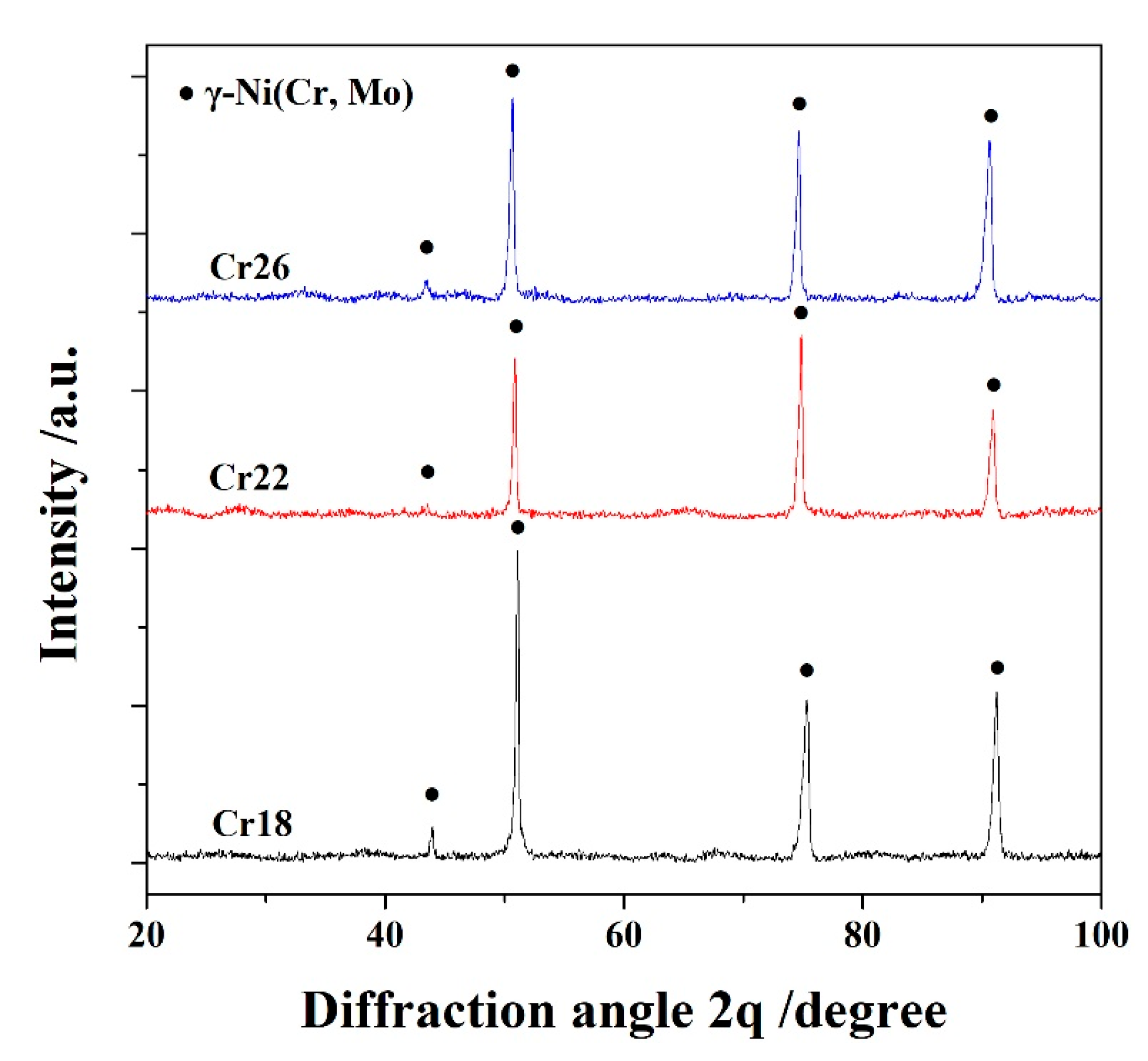

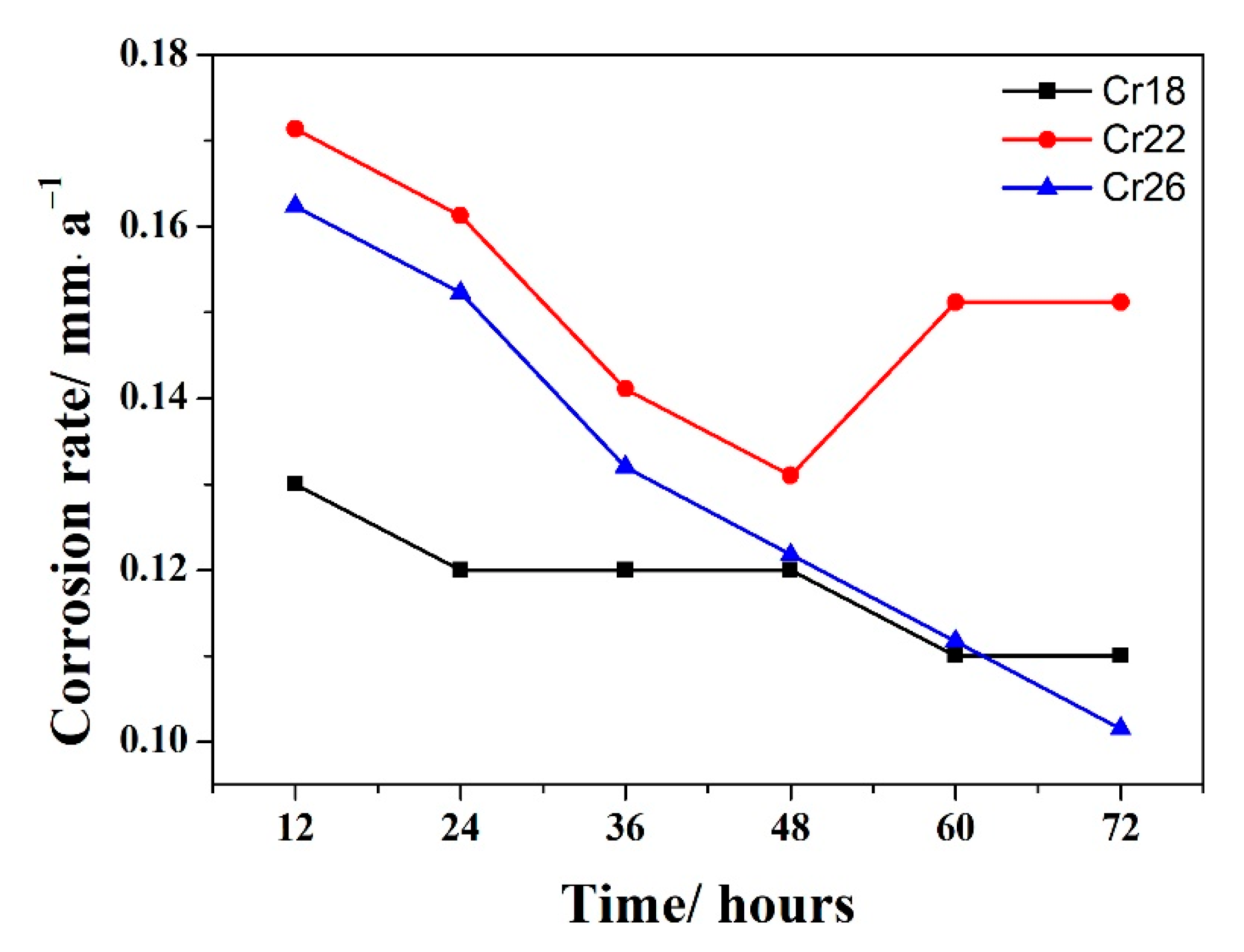


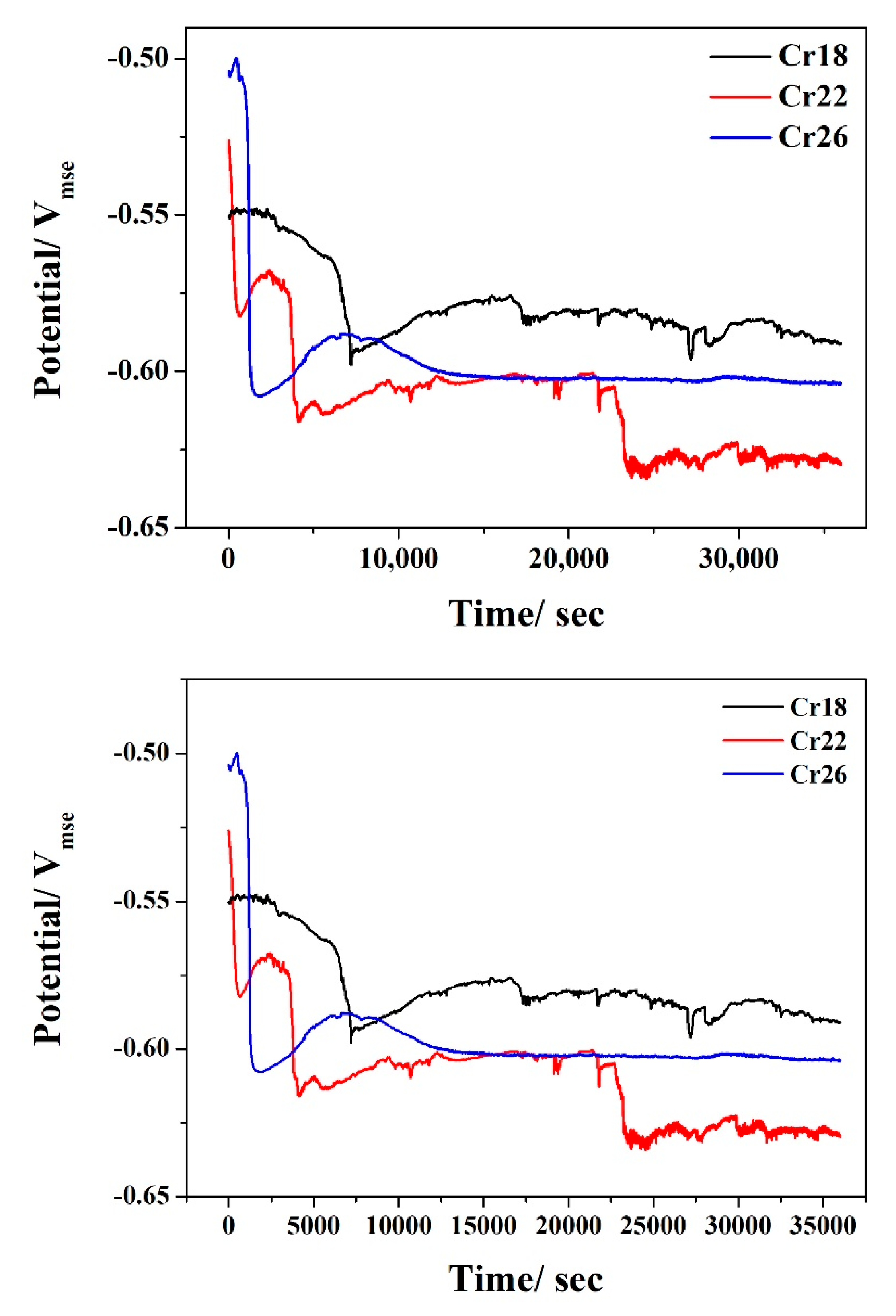

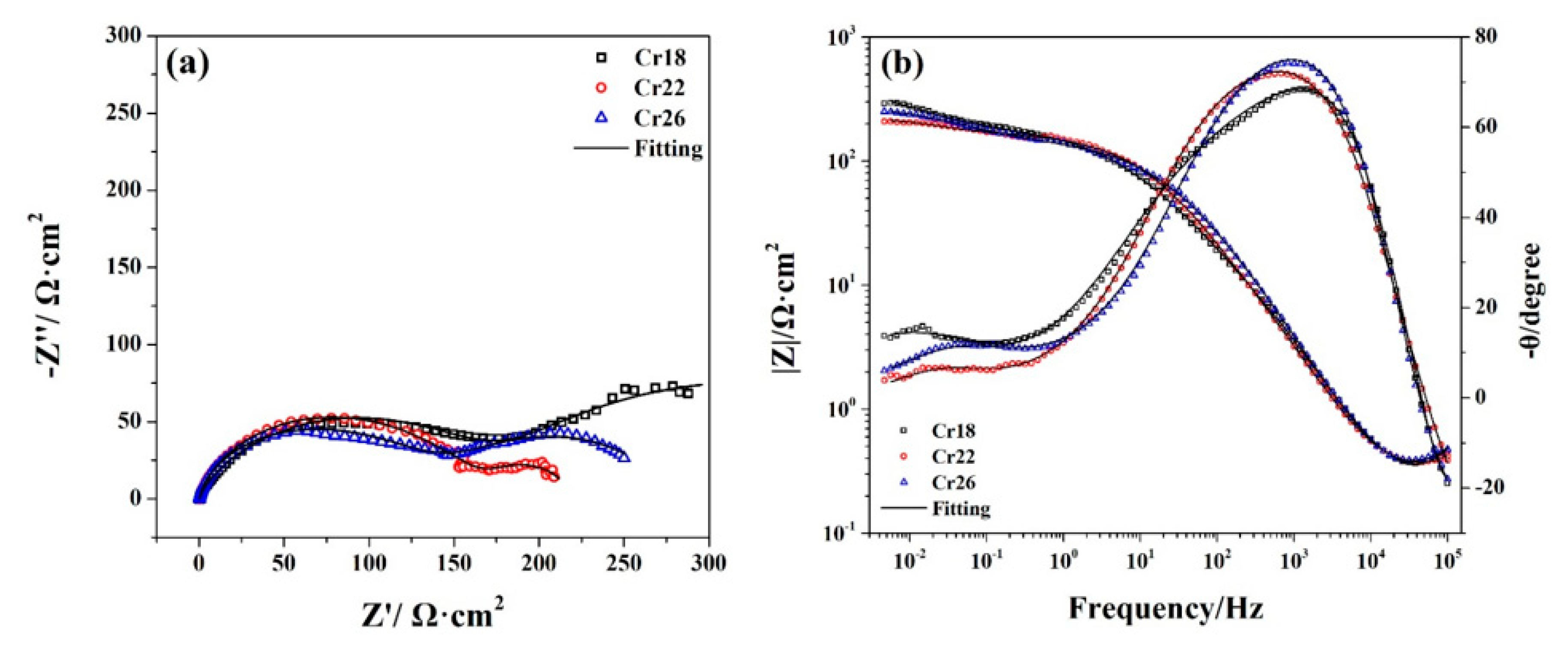
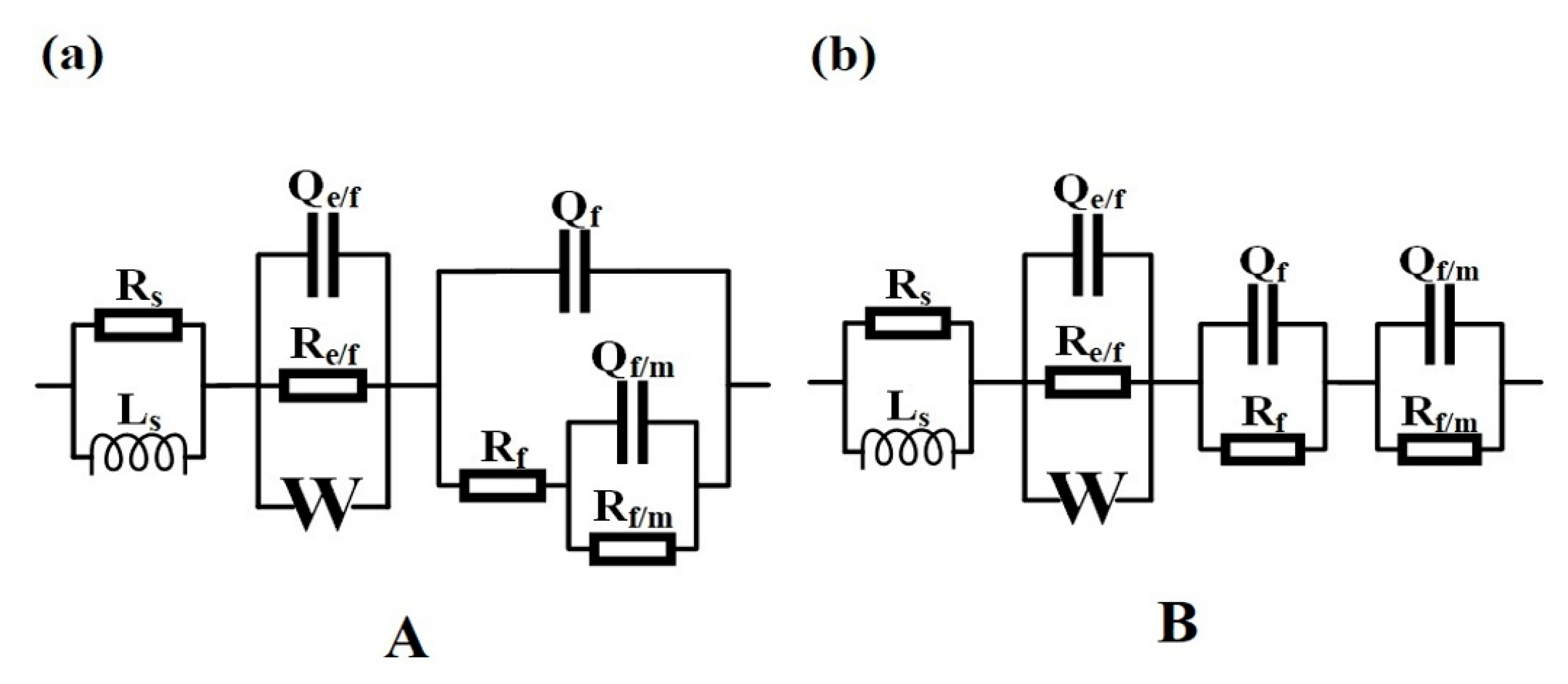
| Material | Ni | Cr | Mo |
|---|---|---|---|
| Cr18 powders | 69 | 18 | 13 |
| Cr22 powders | 65 | 22 | 13 |
| Cr26 powders | 61 | 26 | 13 |
| Specimen | Cr18 | Cr22 | Cr26 |
|---|---|---|---|
| Re/f/Ω·cm2 | 315.8 | 176.1 | 153.4 |
| Qe/f/F·cm2 | 2.225 × 10−2 | 8.280 × 10−5 | 3.684 × 10−5 |
| ne/f | 0.9628 | 0.9308 | 1.000 |
| Rf/Ω·cm2 | 0.5830 | 43.98 | 127.2 |
| Qf/F·cm2 | 7.542 × 10−4 | 1.243 × 10−1 | 2.716 × 10−2 |
| nf | 0.5941 | 0.8429 | 0.6577 |
| Rf/m/Ω·cm2 | 184.9 | 0.3492 | 0.3582 |
| Qf/m·cm2 | 2.806 × 10−5 | 7.049 × 10−12 | 2.725 × 10−14 |
| nf/m | 0.9852 | 0.4173 | 0.8730 |
| Errors | 4.769 × 10−4 | 2.695 × 10−4 | 3.229 × 10−4 |
Publisher’s Note: MDPI stays neutral with regard to jurisdictional claims in published maps and institutional affiliations. |
© 2022 by the authors. Licensee MDPI, Basel, Switzerland. This article is an open access article distributed under the terms and conditions of the Creative Commons Attribution (CC BY) license (https://creativecommons.org/licenses/by/4.0/).
Share and Cite
Zheng, C.; Liu, Z.; Liu, Q.; Kong, Y.; Liu, C. Effect of Cr on Corrosion Behavior of Laser Cladding Ni-Cr-Mo Alloy Coatings in Sulfuric Acid Dew Point Corrosion Environment. Coatings 2022, 12, 421. https://doi.org/10.3390/coatings12040421
Zheng C, Liu Z, Liu Q, Kong Y, Liu C. Effect of Cr on Corrosion Behavior of Laser Cladding Ni-Cr-Mo Alloy Coatings in Sulfuric Acid Dew Point Corrosion Environment. Coatings. 2022; 12(4):421. https://doi.org/10.3390/coatings12040421
Chicago/Turabian StyleZheng, Chao, Zongde Liu, Quanbing Liu, Yao Kong, and Congcong Liu. 2022. "Effect of Cr on Corrosion Behavior of Laser Cladding Ni-Cr-Mo Alloy Coatings in Sulfuric Acid Dew Point Corrosion Environment" Coatings 12, no. 4: 421. https://doi.org/10.3390/coatings12040421
APA StyleZheng, C., Liu, Z., Liu, Q., Kong, Y., & Liu, C. (2022). Effect of Cr on Corrosion Behavior of Laser Cladding Ni-Cr-Mo Alloy Coatings in Sulfuric Acid Dew Point Corrosion Environment. Coatings, 12(4), 421. https://doi.org/10.3390/coatings12040421






